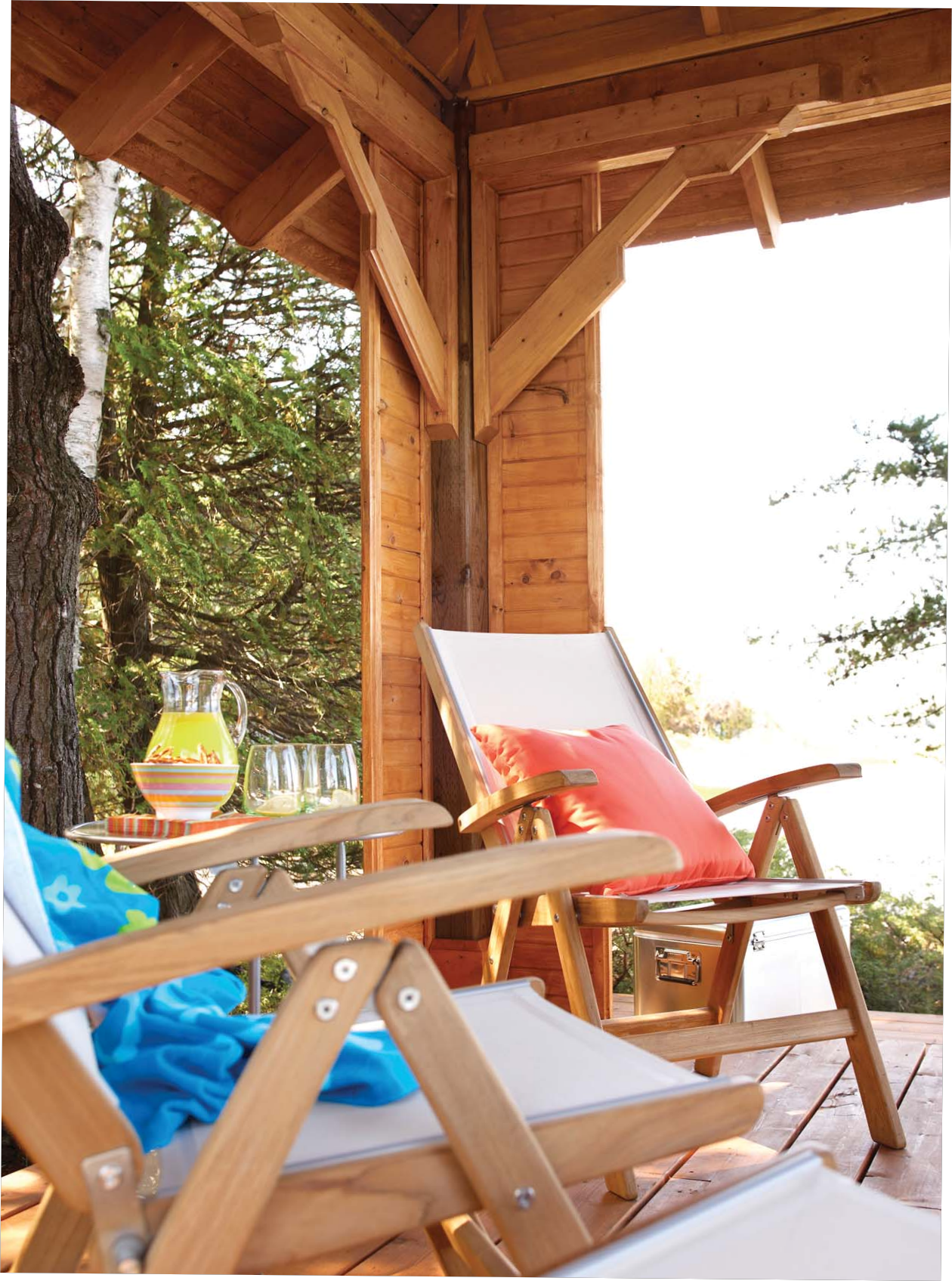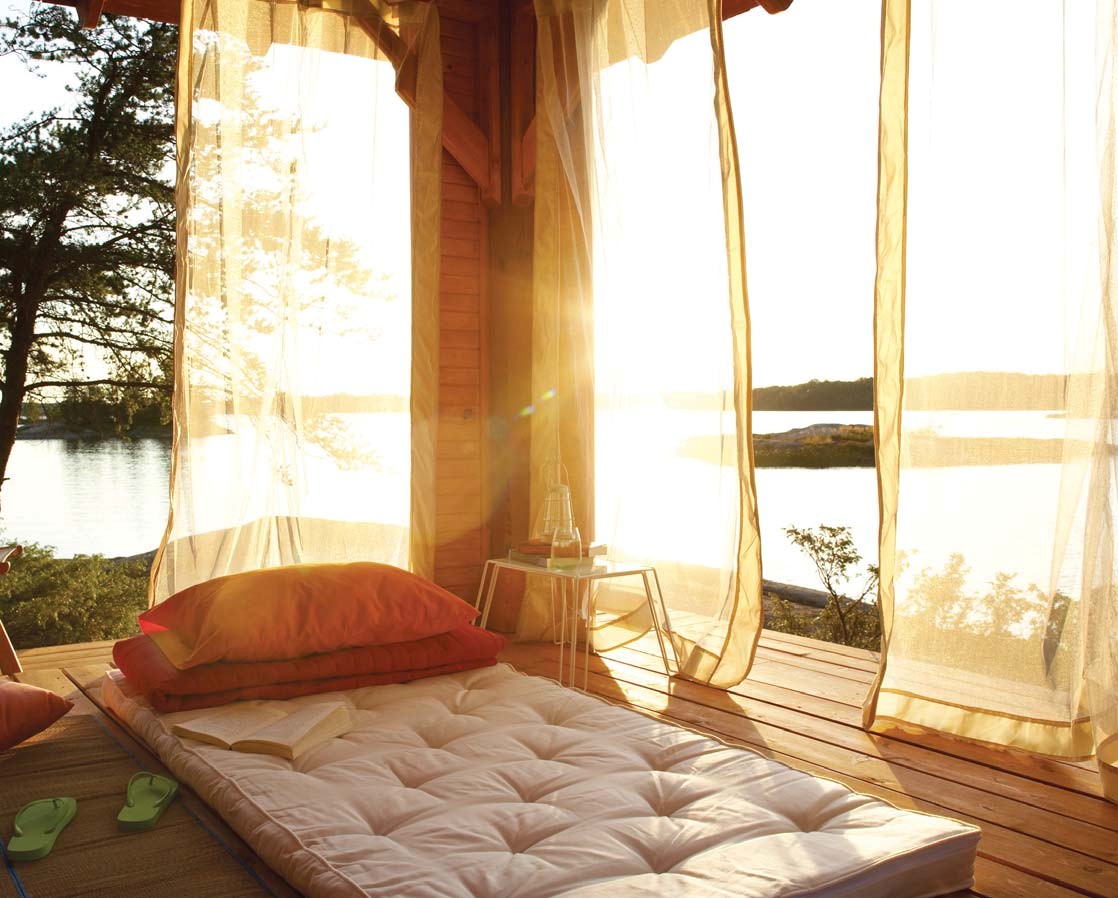|


 


Top row: Two underside
views of the roof structure, showing the rafters,
collar ties, and flared rafter tails; floor
structure and side panel.
Bottom row: Plinth blocks and side panels, from
inside; the storage box opens to reveal space for a
cooler and more. |
As soon as the
hammering began, interest around the bay was piqued.
First, a pedal boat cruised by; the pedallers had
heard construction noise and wanted to see what was
going on. Their compliments were enough to make this
old builder’s heart swell with pride. Then a
neighbor showed up in her bow rider. Now she wants
one for her place. And according to Enid and Doug—
the owners of the project—there has been a virtual
parade of curious boaters ever since.
The inspiration for this “outdoor room” project came
from an unusual direction—in cottage country anyway:
the traditional buildings of Bali, Indonesia. There,
the typical living space is an open, roofed pavilion
with a raised floor, called a bale. Like an
old-fashioned, one-room cottage, these
uncomplicated, elegant structures are used for just
about everything—eating, sleeping, working,
lounging, and conversation. In public spaces, some
are used for music and dance performances, others as
temples.
We kept some Balinese hallmarks—the wide, flared
eaves for shade and rain cover, the floor raised to
bench height, the uncomplicated, four-square layout
for maximum versatility—and used traditional
Canadian cottage materials, such as cedar shakes for
the roof instead of thatch. As well, we added a
hidden, mouse resistant storage box that’s roomy
enough for stowing an air mattress, some folding
chairs, your yoga mat, or a couple of trashy novels
and some sunscreen. In the end, this outdoor room is
an eye-catching hybrid that will fit your cottage
lifestyle because, well, it adapts easily to your
own favorite activities.
|
|
 |
|
 |
The basic gazebo
structure
Since we built right on exposed rock, prepping the
site for our gazebo was reasonably straightforward.
If possible, choose a flat spot to simplify the
build. With its hip roof, building your own gazebo
involves much work that’s not at ground level—I
recommend renting scaffolding to make the job safer
and faster. As well, when you’re working on the
roof, a helper or two on the ground is really
essential. Safety first, on a job like this.
1. I rented a rock drill to bore four ¾ " holes for
6x6 post saddles, seating their rebar anchors with
an epoxy anchoring adhesive (available at industrial
fastener suppliers). Where the soil is deep, seat
the posts in concrete filled 10" Sonotubes. Position
the saddles accurately, before you epoxy them, so
they’re plumb and square.
2. No matter how careful you are when setting the
saddles in the concrete, you’ll still need to adjust
the posts for plumb and square. The easiest way to
do this is by doing a test run with short pieces of
6x6 in the saddles, instead of trying to man oeuvre
the heavy full-length posts. In most cases, you can
use the off cuts from the posts. Because I was
building on even terrain, I calculated from the
plans that I’d need 9'1½ " for each of the posts;
leaving some margin of error, I could afford to cut
8" pieces from my 10'-long 6x6s. Check your own
situation carefully before cutting. Shift the short
pieces in the saddles as needed to get everything
square and plumb, and then replace with the full
length posts, duplicating the adjustments you made
with the short stubs. |
|
 |
|
 |
|
Free
Garden Gazebo Plans
(Right Click on Image, and Select View as Image or
Save As to See the FULL SIZE Picture)
 |
This plan is continued on
page 2.....
If you like this free gazebo plan, you should check out the
ones we charge for!
Please make sure you check out our
complete gazebo plans package before you leave our
site and see if they meet your needs!
|











